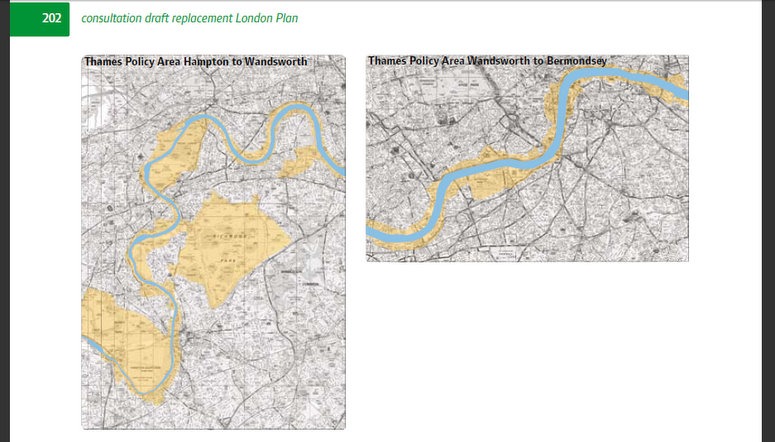You can download the .pdf and comment the draft of Mayor Boris Johnson’s London Plan 2009. The most interesting chapters, for me, are Chapter 6 on Transport and Chapter 7 on London’s Living Spaces and Places. The Gardenvisit website has a historical analysis of previous Open Space Plans for London and I have a special interest in Boris’s plan because he is the only politician I have ever voted for who has been elected. Briefly, my comments on the 2009 draft of the London Plan are as follows.
- The section on Cycling is very welcome – and Boris won my vote by supporting this cause. I hope I live long enough to ride into the capital on a Cycle Super Highway, but since Ken Livingstone promised something similar when he was first elected I am maintaining a healthy skepticism. The policy that ‘to bring about a significant increase in cycling in London, so that it accounts for at least 5 per cent of modal share by 2026’ is insufficiently ambitious. ‘In 2003 fully 36% cycled to workplaces in Copenhagen whereas only 27% drove to work’.
- The Blue Ribbon Strategy, also introduced by Livingstone, is very wise and very welcome. But it needs some tough political muscle behind it.
- The Walking Strategy, based on my 1992 Green Strategy for London, is supported by Boris as it was by Ken, with thanks to them both.
- The plan for a Hierarchy of Open Space in London is as irrelevant today as when it was first advanced by the GLC in 1969. I can only think that it survives because there is standard textbook a Town and Country Planning which supports this kind of absurdity.
- The Green Belt and Metropolitan Open Land ideas are supported for the very good reason that there would be a public outcry if they were not supported. The fact that they have no obvious affect on planning decisions scarcely matters.
- The Biodiversity Strategy is welcome. But there should also be a strategy for the diversification of open space types. London has far too much generalized public open space and not nearly enough specialized public open space. See blog comment on Urban parks, POS and landscape architecture.
- The introduction of Thames Policy Areas, based on Thames landscape strategy, is welcome but does not go far enough. The Thames needs a Scenic Quality Appraisal and then zoning to show (1) zones where there should be a presumption in favour of conserving the existing character (2) zones where there should be a presumption in favour of changing the existing character – because the scenic quality is low. See blog comment on the Millennium London Eye.
- An All London Green Grid became a supplement to the plan in 2011-2012
CONCLUSIONS ON THE LANDSCAPE SECTIONS OF THE MAYOR’S LONDON PLAN
1) The 2009 London Plan is qualitatively inferior to the 1943 Open Space Chapter of the Abercrombie Plan for London. The latter is obsolete in most respects but it had the great merit of taking a simple, clear and idealistic view of the problems and the opportunities. Abercrombie was a member of the Institute of Landscape Architects and had a deep understanding of the subject.
2) If the Greater London Authority is unable to afford the cost of expert landscape consultants, I modestly point them to the Green Strategy I prepared for the London Planning Advisory Committee in 1992. The Mayor’s London Plan is over halfway to adopting the principle of a series of overlapping green networks (for Rivers, Walks, Cycling, and Habitats). These layers should now be INTEGRATED on a Londonwide basis.
3) Town planners should not have responsibility for landscape and open space planning unless they also hold professional qualifications in landscape architecture. I do not know who wrote the landscape sections of the 2009 Draft but they do not read like the work of imaginative, well-educated and influential landscape planners.


Yes Tom I agree Abercrombie was ahead of his time. The way we move through the landscape is important not just the scenic destinations!
Richard Serra’s art is famous for demonstrating this phenomenon.
[ http://strangersouvenez.wordpress.com/2008/06/08/material-subject-content-celebration/ ]
Who designs the streets in modern cities? Nobody. Engineers do the roads; architects do some of the buildings; landscape architects plant some of the trees. The street just happens. As a planning experiment, we could ask Richard Serra to design an installation to inspire the spatial corridor for a street for an urban regeneration project in London.
I hope indeed that BOris’s opening words are spoken with backbone and with real intent – for they are good words and ring true. However if London seeks this ‘reputation’ then it must invest in it NOW as opposed to just talking it. Architecture / events / green ‘pockets’ take years to produce but the wider urban landscape takes decades to begin and centuries to evolve and grow….
“To make that shared space safer, we need
to make it more beautiful. That is why we
are seeking a world reputation for new and
improved public spaces that Londoners will
cherish for decades to come.” Boris JOhnson
His statement should really look further than decades, however I will take decades for now….
Do you think Boris was thinking about cyclists when he said shared spaces should be safer aka more beautiful?
Yes! He is a very keen cyclist, as is the leader of the Conservative Party. Boris is the only politician I have ever voted for who has been elected.